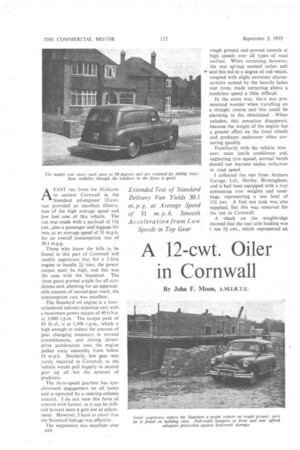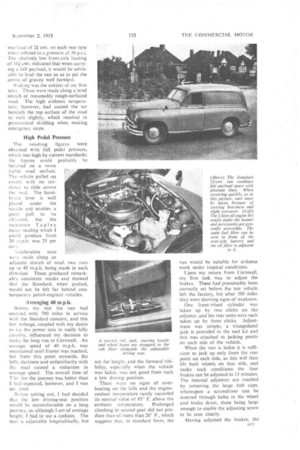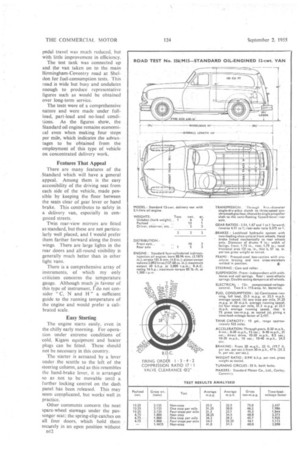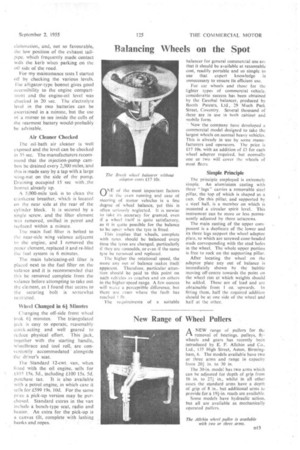A 12-cwt. Oiler in Cornwall
Page 50

Page 51

Page 52

Page 53

If you've noticed an error in this article please click here to report it so we can fix it.
By John F. Moon, A.M.I.R.T.E.
AFAST run from the Midlands to eastern Cornwall in the Standard oil-engined 12-cwt. van provided an excellent illustration of the high average speed and low fuel cost of this vehicle. The run was made with a payload of 13f cwt., plus a passenger and luggage for two, at an average speed of 31 m.p.h. for an overall consumption rate of 30.1 m.p.g.
Those who know the hills to be found in this part of Cornwall will readily appreciate that for a 2-litre engine to handle 21 tons, the power output must be high, and this was the case with the Standard. The three gears proved ample for all conditions and, allowing for an appreciaable amount of second-gear work, the consumption rate was excellent.
The Standard oil engine is a fourcylindered indirect-injection unit with a maximum power output of 40 b.h.p. at 3,000 r.p.m. The torque peak of 85 lb.-ft. is at 1,500 r.p.m., which is high enough to reduce the amount of gear changing necessary in normal circumstances, and during directdrive acceleration tests the engine pulled away smoothly from below 10 m.p.h. Similarly, low gear was rarely required in Cornwall, as the vehicle would pull happily in second gear up all but the severest of gradients.
The three-speed gearbox has synchromesh engagement on all ratios and is operated by a steering-column control. I do not view this form of control with favour, as it can be difficult to reset once it gets out of adjustment. However, I have to admit that the Standard linkage was effective.
The suspension was excellent over rough ground and proved smooth at high speeds over all types of road surface. When cornering, however, the rear springs seemed rather soft • and this led to a degree of roll which, coupled with slight oversteer characteristics caused by the heavily laden rear tyres, made cornering above a moderate speed a little difficult.
In the same way, there was pronounced wander when travelling on a straight course and this could be alarming to the ithinitiated. When unladen, this sensation disappears, because the weight of the engine has a greater effect on the front wheels and produces understeer when cornering quickly.
Familiarity with the vehicle, how ever, soon instils confidence and, neglecting tyre squeal, normal bends should not warrant undue reduction in road speed.
I collected the van from Archers Garage, Ltd., Shirley, Birmingham, and it had been equipped with a tray -containing iron weights and sandbags, representing a test load of 131 cwt. A fuel test tank was also supplied, but this was removed for the run to Cornwall.
A , check on the weighbridge showed that the rear axle loading was 1 ton 5f cwt., which represented an
overload of 2i cwt. on each rear tyre when inflated to a pressure of 30 p.s.i. The relatively low front-axle loading of I 6.Z cwt. indicated that when carrying a full payload, it would be advisable to load the van so as to get the centre of gravity well forward.
Braking was the subject of my first tests. These were made along a level stretch of reasonably rough-surfaced road. The high ambient temperature. however, had caused the tar beneath the top surface of the road to melt slightly, which resulted in pronounced skidding when making emergency stops.
High Pedal Pressure The resulting figures were obtained with full pedal pressure, which was high by current standards; the ligures could probably be bettered on a more staf)le road surface. The vehicle pulled up evenly with no tendency to slide across the road. The handbrake lever is well placed under the scuffle and enables a good pull to be obtained, but the maximum Tapley meter reading which I could produce from 20 m.p.h. was 25 per Cent.
ceeleration tests were made along an adjacent stretch of road, two runs up to 40 m.p.h. being made in each direction. These produced remarkably consistent results and showed that the Standard, when pushed, would not be left far behind contemporary petrol-engined vehicles.
Before my test the van had covered only 700 miles in service with the Standard concern, and this low mileage, coupled with my desire to try the power unit in really hilly country, influenced my decision to make the long run to Cornwall. Art average speed of 40 m.p.h. was maintained until Exeter was reached, but from this point onwards, the hills, darkness and unfamiliarity with the road caused a reduction in average speed. The overall time of 7 hr. for the journey was .better than I had expected, however, and I was not tired.
I3efore setting out, I had decided that the low driving-seat position would be uncomfortable on a long journey, so, although I am of average height. .I had to use a cushion: The seat is adjustable longitudinally, but
not for height, and the forward visibility, especially when the vehicle was laden, was not good from such a low driving position.
There were no signs of overheating on the hills and the enginecoolant temperature rarely exceeded its normal value of 85° F. above the ambient temperature. Prolonged climbing in second gear did not produce rises of more than 20° F., which suggests that. in standard form, the
van would be suitable for arduous work under tropical conditions.
Upon my return from Cornwall, my first task was to adjust the brakes. These had presumably been correctly set before the test vehicle left the factory, but after 500 miles they were showing signs of weakness.
One front-wheel cylinder was taken up by two clicks on the adjuster, and the rear units were each taken up by three clicks. Adjustment was simple; a triangulated jack is provided in the tool kit and this was attached to jacking points on each side of the vehicle.
When the van is laden it is suffi cient to jack up only from the rear point on each side, as this will then lift both wheels on that side, and under such conditions the four brakes can be adjusted in 13 minutes. The internal adjusters are reached by removing the large hub caps, whereupon a screwdriver can be inserted through holes in the wheel and brake drum, these being large enough to enable the adjusting screw to be seen clearly.
Having adjusted the brakes, the pedal travel was much reduced, hut with little improvement in efficiency.
The test tank was connected up and the van taken on to the_ main Birmingham-Coventry road at Sheldon for fuel-consumption tests. This road is wide but busy and undulates enough to produce representative figures such as would be obtained over long-term service.
The tests were of a comprehensive nature and were made under fullload, part-load and no-load conditions. As the figures show, the Standard oil engine remains economical even when making four stops per mile, which indicates the advantages to be obtained from the employment of this type of vehicle on concentrated delivery work.
Features That Appeal
There are many features of the Standard which will have a general appeal. Among them is the easy accessibility of the driving seat from each side of the vehicle, made possible by keeping the floor between the seats clear of gear lever or hand brake. This contributes to safety in a delivery van, especially in congested streets.
Twin rear-view mirrors are fitted as standard, but these are not particularly well placed, and I would prefer them farther forward along the front wings. There are large lights in the rear doors and all-round visibility is generally much better than in other light vans.
There is a comprehensive array of instruments, of which my only criticism concerns the temperature gauge. Although much in favour of this type of instrument, rdo not consider "C, N and H" a sufficient guide to the running temperature of the engine and would prefer a calibrated scale.
Easy Starting
The engine starts easily, even in the chilly early morning. For operation under extreme conditions of cold, Kigass equipment and heater plugs can be fitted. These should not be necessary in this country.
The starter is actuated by a lever under the scuttle to the left of the steering column, and as this resembles the hand-brake lever, it is arranged so as not to be movable until a further locking control on the dash panel has been released. This may seem complicated, but works' well in practice.
Other comments concern the neat spare-wheel stowage under the passenger seat; the spring-clip catches on all four doors, which hold them securely in an open position without
elaboration, and, not so favourable, die low position of the exhaust tailpipe. which frequently made contact with the kerb when parking on the or side of the road. _ For my maintenance tests I started off by checking the various levels. the alligator-type bonnet gives good accessibility to the engine compartment and the engine-oil level was checked in 20 sec. The electrolyte level in the two batteries can be ascertained in a minute, but the use of a mirror to see inside the cells of the rearmost battery would•probably be advisable.
Air Cleaner Checked [he oil-bath air cleaner is well exposed and the level can be checked in 35 sec. The manufacturers recommend that the injection-pump earnbox be drained every 2,500 miles,'and this is made easy by a tap with a large wing-nut on the side of the pump. Draining occupied 15 sec with ethic
bonnet already up. •
A 5,000-mile task is to clean the crankcase breather, which is located on the near side at the rear of the cylinder block. It is secured by a single screw, and the filter element was removed, swilled in petrol and replaced within a minute.
The main fuel filter is bolted to the near-side wing valance adjacent to the engine, and I removed the paper element, replaced it and re-bled the fuel system in 6 minutes,
The main lubricating-oil filter is placed next to the fuel filter on the valance and it is recommended that this be removed complete from the valance before attempting to take out the element, as I found that access to the securing bolt is somewhat retricted.
Wheel Changed in 64; Minutes
Changing the off-side front wheel took 61 minutes. The triangulated jack is easy to operate, reasonably quick-acting and well geared to reduce physical effort. This jack, together with the starting handle, wheelbrace and tool roll, are conveniently accommodated alongside the driver's seat.
The Standard. 12-cwt. van, when titled with the oil engine, sells for It 15 15s. 5d., including £100 15s. 5d.
purchase tax. It is also available with a petrol engine, in which case it sells for £599 19s. 10d. For the same price a pick-up version may be purchased. Standard extras in the van include a bench-type seat, radio and heater. Art extra for the pick-up is a canvas tilt, complete with lashing hooks and ropes.
















































































































